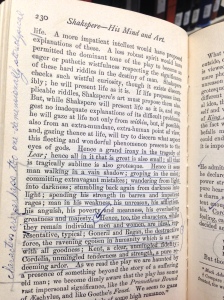I found this marginalia in the book “Shakspere – A Critical Study of his Mind and Art” by Edward Dowden and made a submission to Book Traces. The call number at the Sojourner Truth Library is Stacks PR2976 .D6 1900. This version of the book was published in 1900, and the original was published in 1875. This was Dowden’s first book, and helped him to become widely acknowledged as a critic of Shakespearian literature.
The first image of marginalia shows that the reader underlined an entire section and wrote “IMPORTANT” in the margin, perhaps as if the reader was using this section to include in a research project or in work for a class. Perhaps the checkmarks symbolize where an important section starts off or ends. It is clear that the reader was annotating in order to keep note of certain sections of Dowden’s criticism.
The second image of marginalia shows that the reader wrote “characters are perhaps too one-dimensionally stereotypical,” presumably summing up Dowden’s criticism of Shakespearian characters. In this section, the book reads “Hence, too, the characters , while they remain individual men and women, are ideal, representative, typical” – this shows Dowden’s tendency to analyze and criticize Shakespeare’s writing and character creation. The reader is practicing the form of annotation that includes summarizing the writer’s thoughts on the margin for easy reference and understanding – something that I have personally always found helpful. His or her marginalia helped me to have an idea of what was written on the page before I even read it – and I knew nothing about this book when I first spotted the marginalia.
Overall, I felt that this was a very interesting lab and I enjoyed searching through the stacks to find interesting and unique marginalia!









